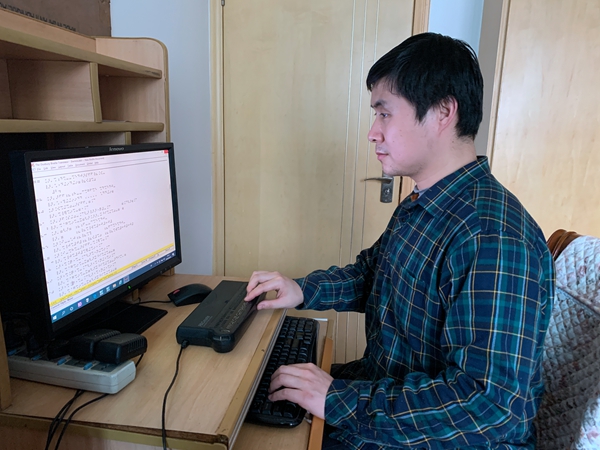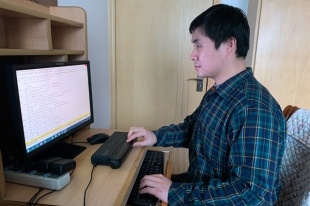Blind pianist's transcription project helps improve music access


For months, the COVID-19 outbreak might have shrouded the city of Wuhan, Hubei province, in a haze of uncertainty. But it has failed to sweep away blind musician Hu Haipeng's passion for his job-transcribing music score used by sighted people into braille.
Living in the city hit the hardest in China, Hu maintains his usual daily routine of transcription, project maintenance and indoor physical exercise.
The project maintenance mainly refers to the nonprofit Open Braille Music project he launched in 2016, which is dedicated to providing free braille music scores and other information for blind musicians from home and abroad. Hu himself completes most of the project work.
On Feb 7, after several days' effort, he uploaded a braille version of the symphonic poem Monument to the People's Heroes, composed by Qu Wei in the early 1960s, to the project's website.
He wants to dedicate the transcription work to the thousands of medical workers fighting the epidemic on the front lines.
Born blind in 1984, he began learning the piano as a child. He was tempted to learn composition at the Wuhan Conservatory of Music, but was held back from a systematic education in the area because there was hardly any accessible braille score for chamber ensemble and orchestra.
He could only continue to learn the piano at the conservatory, because the braille score was relatively easier to obtain. Since 2003, his family has been purchasing braille score from abroad, first with the help of their acquaintances, and later by buying it online.
He has tried his hand at composition, though. The pieces he considers his best are an adaptation of the famous piece, Jasmine Flower, in an arrangement where he joined the titular Chinese folk song with another to form one singular composition, and Dance of Heart, an overture for symphony orchestra he completed in 2013.
The lack of braille score for chamber ensemble and orchestra remains an issue because it requires high proficiency in both braille notations and the music forms. It's also expensive.
Several years ago, when he was about to transcribe a printed score into braille, he came up with the idea of setting up a project to not only share his work, but to pave the way for blind music enthusiasts who want to learn composition and music production.
In 2017, it took him just two weeks to transcribe the full score of Maurice Ravel's ballet Daphnis et Chloe, a nearly one-hour piece of music that fills 317 pages in its regular format.
The majority of the more than 300 braille transcripts on the project's website are scores for chamber and orchestral pieces, apart from some for violin, the piano and vocal music.
On the website, he has also listed tips on how to read the braille score, commonly used musical terms and links to where the users can maximize the benefits of open resources of braille music and technologies online.
Hu makes it possible by transferring the printed scores into music notation software like Finale and Sibelius, exporting them into MusicXML-the standard open format for exchanging digital sheet music-before converting them into braille, post-editing, with a braille note-taker like PAC Mate.
For him, the key to such a job is to acquire printed scores in formats that fit the notation software he uses, and he has a lot of support from UK-based Scores Reformed, a program that reproduces clear and high-quality copies of full scores, as well as parts of both operatic and orchestral works.
However, the limited printed score resources have stopped him from doing more.
Hu also serves as the technique consultant for the Daisy Consortium, a transnational organization to secure the prospect of hard-copy braille music production and improve digital music technologies for blind musicians.
For most of the braille presses worldwide, transcription relies largely on manual work.
According to Gao Xu, who takes charge of braille score transcription at the Beijing-based China Braille Library, they would prefer to let editors read the printed scores and type them into braille manually if the automated transcription software cannot guarantee an accuracy that is close to 100 percent.
Otherwise, it would take much more, unnecessary, effort to compare the two versions, find the errors and correct them.
For the other part of Hu's project he calls BrailleOrch, he works with the Daisy Consortium to discuss ways to improve the software technology so that the process of exporting MusicXML files and converting them into braille automatically can be smoother and more accurate.
They also look into ways of more effectively sharing resources among blind musicians all over the world.
Having been in touch with related software programmers from countries including Japan and Germany for over a decade, he is now seeking a helping hand in developing a real software on the basis of the framework he has designed.
"My confidence comes from the opportunities I have grasped, exerting my strength to create more braille score resources and enhance the development of braille transcription technology, to reduce the difficulty for blind music learners like me," Hu says.





































